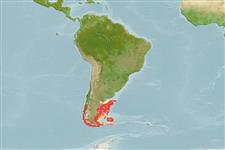Common names from other countries
Environment: milieu / climate zone / depth range / distribution range
Écologie
; saumâtre; profondeur 0 - 100 m (Ref. 356). Temperate, preferred 10°C (Ref. 107945); 40°S - 56°S, 76°W - 36°W
Southeast Pacific, Southwest Atlantic and the Antarctic.
Length at first maturity / Taille / Poids / Âge
Maturity: Lm ? range ? - ? cm Max length : 18.0 cm SHL mâle / non sexé; (Ref. 356)
This is an epifaunal species found on soft sandy and muddy bottoms and diverse rocky substrates including cobbles and associated with holdfasts or fronds of brown algae in inner fjords, channels and exposed areas (Ref. 87801).
Life cycle and mating behavior
Maturité | Reproduction | Frai | Œufs | Fécondité | Larves
Members of the class Bivalvia are mostly gonochoric, some are protandric hermaphrodites. Life cycle: Embryos develop into free-swimming trocophore larvae, succeeded by the bivalve veliger, resembling a miniature clam.
Häussermann, V. and G. Försterra. 2009. (Ref. 87801)
Statut dans la liste rouge de l'IUCN (Ref. 130435)
statut CITES (Ref. 108899)
Not Evaluated
Not Evaluated
Utilisations par l'homme
Pêcheries: commercial
FAO - Aquaculture: production; pêcheries: landings | FishSource | Sea Around Us
Outils
Sources Internet
Estimates based on models
Prior r = 0.43, 95% CL = 0.28 - 0.64, Based on 1 data-limited stock assessment.
Vulnérabilité
Low vulnerability (10 of 100).
